Mealtime Partners, Inc.
Specializing in Assistive Dining and Drinking Equipment
February 2014 Independent Eating and Drinking Newsletter

|
February Topics:
|
||
|
Mealtime Partners Home Page Send a Comment or Suggestion |
|||
| Subscribe to Newsletters |
In last month’s Newsletter in the article "How the Sense of Smell Affects Taste" we discussed how our sense of smell affects our ability to taste. The article did not include information about difficulties that can be experienced with smell; however, a deviation from the normal sense of smell can cause those affected by it considerable discomfort. Some individuals have a heightened, or exaggerated, sense of smell which is called hyperosmia. Other individuals have a decreased ability to smell which is called hyposmia, or an inability to smell, called anosmia. It is estimated that approximately 4 million people in the United States suffer from problems with their sense of smell.
Hyperosmia comes from the Greek word "hyper" meaning "above," and the Greek word "osme" meaning "sense of smell." People who have hyperosmia have increased olfactory acuity. This translates into not only a more acute sense of smell but an increased awareness of taste or flavor.
| For people with hyperosmia, smells can
be overwhelming. Household smells, such as cleaning products or
laundry detergent, and personal products like spray deodorants
and perfume can elicit a gag reflex, or cause nausea. For
individuals with this condition, life can be very difficult as
they are overwhelmed by common smells including the smells of
food. Some people have experienced this phenomenon for their
entire life while others develop it at a later time. It is known
to occur in individuals who suffer from migraine or cluster
headaches, those who have experienced head trauma, or have
neurological diseases, or motor neuron diseases. People who suffer from acute hyperosmia can be debilitated by the condition. For example, if a caregiver has used hand sanitizer prior to offering a drink, the smell on their hands can make the drink recipient ill. Therefore, for anyone living or working around someone who has a heightened sense of smell, life can be very demanding. They must be aware of all of the smells that trigger reactions and avoid them. This can be difficult particularly when it comes to food, as cooking smells can be very offensive and thus the particular foods that trigger a reaction should be avoided. This limits the range of foods that can be prepared and eaten. When this condition occurs later in life it is initially very confusing. Things that have been enjoyed as pleasant smells, such as the odor that occurs when an orange is peeled, suddenly are overwhelmingly unpleasant and can cause gagging, retching and/or a feeling that the throat is becoming restricted. |
Anosmia is the inability to perceive odors. It can occur in individuals who have suffered head trauma, and is associated with chronically inflamed nasal passages. It can be present in one or both nostrils depending upon damage, or inflammation. The inability to smell can be dangerous to the person as it removes their ability to smell gas leaks, spoiled food or other noxious smells.
Hyposmia is a reduced ability to smell. It varies from anosmia because some ability to detect odors is present versus no sense of smell. Allergies, viral infections, nasal polyps and head trauma can all be responsible for an individual having hyposmia. However, clinical studies have identified it as being present in individuals with a diagnosis of Parkinson’s disease and a reduced sense of smell is very common in individuals who have Alzheimer’s disease.
This topic is of significance because hyperosmia, hyposmia, or anosmia can all occur as a result of injury, or disease. Changes in one’s sense of smell can impact not only physical and emotional health but quality of life which can be reduced because smell has such a significant impact on the enjoyment of food and eating. When this pleasure is reduced or removed, the result can be weight loss because eating no longer provides the pleasure that it used to.
The final word on smell - For individuals who require mealtime help, changes in their sense of smell can have a great impact on their quality of life, and thus caregivers, family and friends should be vigilant in their efforts to remove unnecessary and offensive smells. Some people are unable, due to illness and/or disability, to remove themselves from the smell!
- - - - - - - - - - - - - - - - - - - - - - - - - - - - - - - - - - - - - - - - - - - - - - - - - - - - - - - - - - - - - - - -
|
Whether it is eating or drinking Mealtime Partners has a HANDS-FREE solution to independence |
|
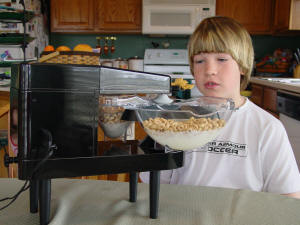
|
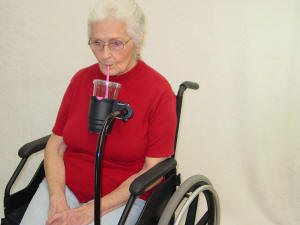
|
| The Mealtime Partner Dining System on Legs | The Front Mounted Drinking System |
| To maintain a healthy
body, lots of fruits, vegetables and other nutritious foods
should be consumed without the need to hurry the pace at which they are
eaten. Additionally, plenty of water should be consumed, all day long. For those individuals who are unable to lift or hold a utensil or who are unable to pick up a cup, maintaining healthful consumption can be difficult. Mealtime Partners products provide a solution. For more information about our dining and drinking products, please visit the Mealtime Partners website. |
|
|
For more information about the most flexible assistive dining system available, please visit: The Mealtime Partner Description, or call us at 800-996-8607. For information about all of our drinking products and for considerations for selecting the appropriate drinking system, click here. |
|
Setting Up the Front Mounted Drinking System
Recently Mealtime Partners received some questions about the Front Mounted Drinking System and this article is intended to answer questions about setting up the drinking system and also provide an overview of how, and why, the system is assembled the way it is.
First, it should be noted that the Front Mounted Drinking System comes fully assembled, and in most cases can be installed immediately on a wheelchair, table, or bed, and with a small amount of bending the Flex Arm, can be positioned for immediate use. However, it is also very flexible in how it can be positioned to accommodate diverse user needs. It can be mounted in a wide range of locations on a wheelchair, both in front of and behind the user, including the wheelchair handle, a vertical bar, or a horizontal bar as shown in the following group of pictures. The upper two pictures show the drinking system mounted on the handle of a wheelchair and illustrate how different lengths of Flex Arm can change the location of the Cup Holder even when the system is mounted at the same location. Note that in the lower right picture, the Clamp is attached to a diagonal shaft of the Wheelchair.
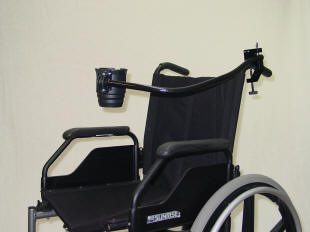 |
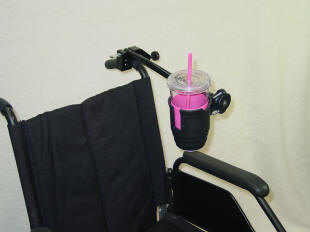 |
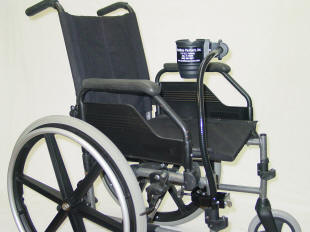 |
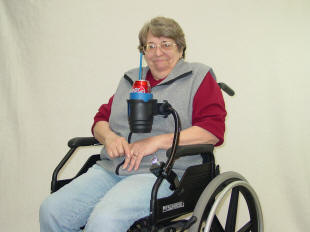 |
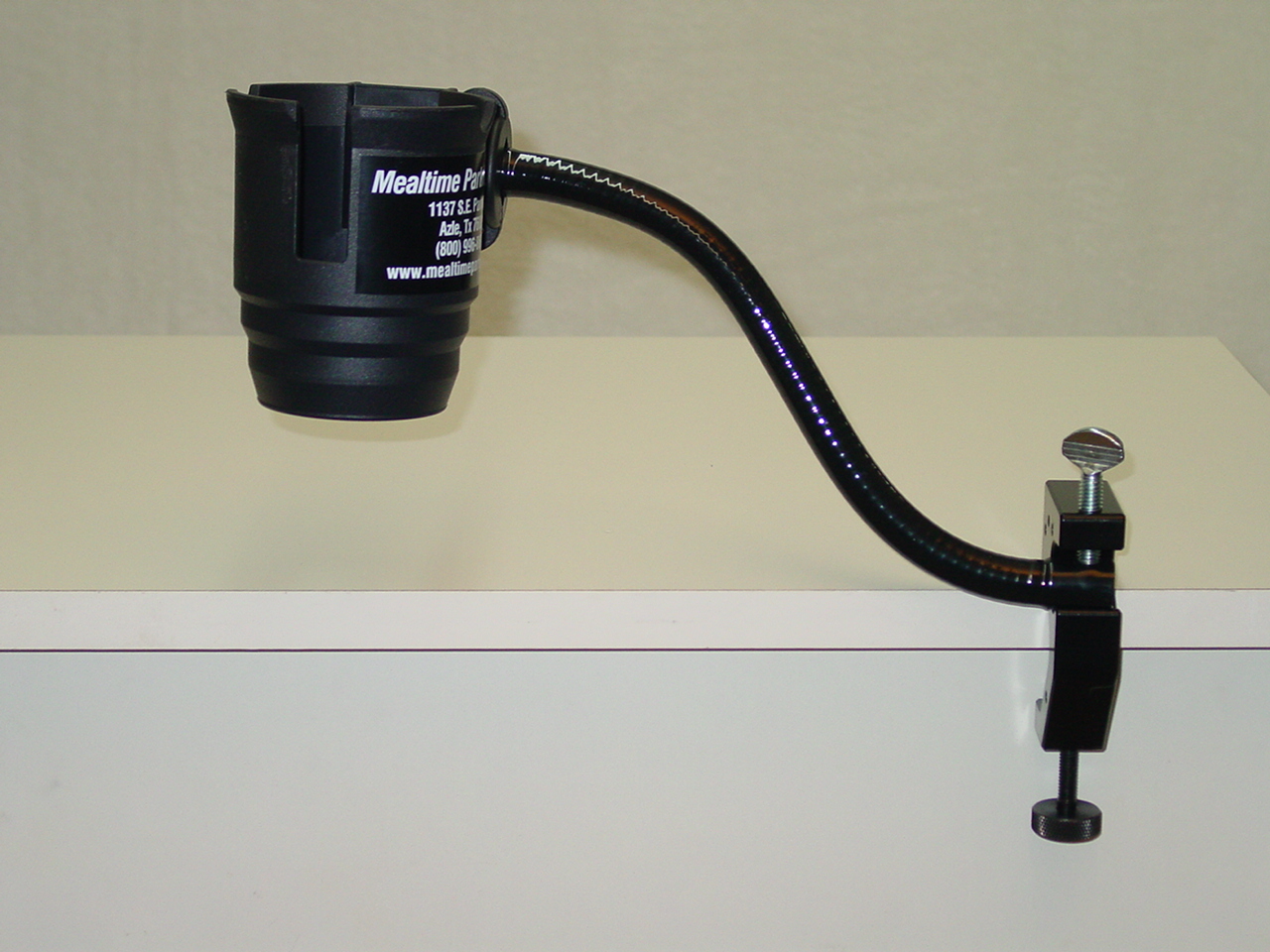 |
Each Front Mounted Drinking System is shipped fully assembled, as illustrated here. The assembly is made up of three different components: the Wheelchair Clamp, a Flex Arm (that come in 5 different lengths from 6 inches to 30 inches), and a Cup Holder. (The Cup Holder has its own mounting clamp for attachment to the Flex Arm). |
The Wheelchair Clamp actually has two clamps in one strong metal body to allow it to be attached to a wheelchair, a bedrail, or table top, and at the same time to securely hold another object (e.g., the Flex Arm). In the picture of the Clamp shown below, the opening that attaches to a wheelchair, etc., i.e., the larger opening in the clamp body, has a black screw (with a swivel head and large handle for secure tightening); the smaller opening that holds the Flex Arm has a silver thumb screw that holds the Flex Arm firmly in position.
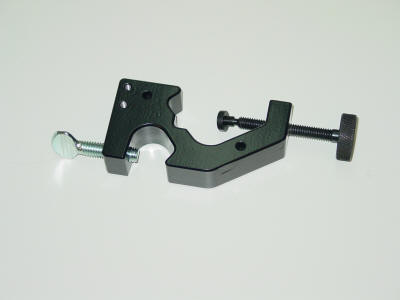
When the Front Mounted Drinking System is shipped, the Flex Arm is positioned in the Clamp and this orientation should not be changed. The silver thumbscrew is positioned on the end section of the Flex Arm. The last inch (i.e., the last section) of each end of the Flex Arm is slightly larger in diameter than the middle, flexible part of the arm, and is solid metal. A small square of the black Flex Arm covering is removed where the thumb screw end is tightened down on the Flex Arm. This allows the metal of the thumb screw to make contact with the metal of the Flex Arm, assuring a firm mount. If the thumbscrew end is positioned on the black arm-covering, the arm can potentially slip. Therefore, the orientation of the Clamp to the Flex Arm should not be changed.
A thumbscrew is used in the design of the Front Mounted Drinking System instead of a permanent screw, to permit the Cup Holder and Flex Arm to be removed from the Wheelchair Clamp. This allows the drinking system to be removed when the user enters and exits the wheelchair, without removing the Wheelchair Clamp from the wheelchair. This feature is available because occasionally the Wheelchair Clamp must be located in a difficult to reach location on the Wheelchair. In most cases the entire drink system assembly is removed from the Wheelchair when a user enter or exits the chair. If the Flex Arm is removed from the Wheelchair Clamp, care should be taken to position the Flex Arm in the Wheelchair Clamp with the exposed metal area of the Flex Arm at the location of the Thumbscrew when it is reassembled.
The Cup Holder is attached to the other end of the Flex Arm. The Cup Holder is supplied with a clamp, as pictured below.
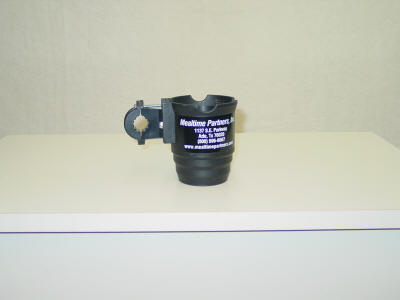
When the Front Mounted Drinking System is shipped from the factory the cup hold is oriented at a 90 degree angle from the Wheelchair Clamp. This orientation accommodates most Wheelchair Clamp locations on a wheelchair. However, if the Cup Holder is not upright when attached to a wheelchair, bed or table, the screws on the Cup Holder Clamp can be loosened and the Cup Holder adjusted as necessary to have it aligned correctly for the user.
- - - - - - - - - - - - - - - - - - - - - - - - - - - - - - - - - - - - - - - - - - - - - - - - - - - - - -
|
Did You Know?
Did you know that the Food and Drug Administration (FDA)
recently announced that the recommended dose for a popular
sleep aid (Ambien, generically called Zolpidem) should
differ for men to women. This finding has led to
investigations into other medicines and it has been found
that low-dose aspirin can lower the risk of heart attack in
healthy men but does not have the same effect for women.
However, it does protect women against stroke. Since gender related differences have been identified, scientists have found shortcomings in the design of research studies because only males were studied. At that time, the logic behind using only men was to avoid the impact that female hormones have upon women which might influence the study results. Even in studies funded by the US Government that require women to be included, data was not analyzed based on gender. Now that this gender effect is known, scientist are beginning to see significant differences that, until recently, have not been identified. This is particularly important in the area of stem cell research. Researchers at Texas Heart Institute in Houston, Texas, when studying plaque buildup in animal models, have found that male and female stem cells (X and Y chromosomes) have different impacts upon plaque reduction in male and females when used to treat this disorder. |
Mealtime Partners Website Navigation:
Home | Dining | Drinking | Videos | All Products | Warranty | Ordering | Calendar | FAQ | Newsletters | Contact
Please send comments and suggestions to newsletters@mealtimepartners.com
Copyright © Mealtime Partners, Inc. 2014
All rights reserved.